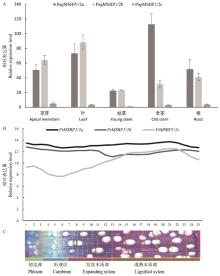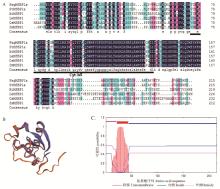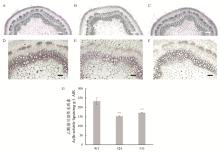

Scientia Silvae Sinicae ›› 2022, Vol. 58 ›› Issue (6): 56-65.doi: 10.11707/j.1001-7488.20220606
Previous Articles Next Articles
Yajing Xu,Jiawei Wang,Yanqiu Zhao,Cheng Jiang*,Lichao Huang,Yi An,Wei Zeng,Jin Zhang,Mengzhu Lu
Received:2021-03-23
Online:2022-06-25
Published:2022-09-24
Contact:
Cheng Jiang
CLC Number:
Yajing Xu,Jiawei Wang,Yanqiu Zhao,Cheng Jiang,Lichao Huang,Yi An,Wei Zeng,Jin Zhang,Mengzhu Lu. Effect of PagMSBP1/2a Gene of 84K Poplar on Lignin Biosynthesis[J]. Scientia Silvae Sinicae, 2022, 58(6): 56-65.
Table 1
Primer sequences for 84K poplar PagMSBP1/2 cloning and qPCR analysis"
| 引物名称 Primer name | 引物序列 Primer sequence (5′-3′) |
| PagMSBP1/2a-q-F | CAGAAAGTGATGCTTCCAAGC |
| PagMSBP1/2a-q-R | CTATTCCTCCTTGGATTCAGCGA |
| PagMSBP1/2b-q-F | GAACGATGTTGCTAAGCCAG |
| PagMSBP1/2b-q-R | ACTCTTCCTTGGATTCACCACC |
| PagMSBP1/2c-q-F PagMSBP1/2c-q-R PagMSBP1/2a-F | GCCGTTATGGTGGTGGTTT TTGTGGTTGTGGTTCTGGTG ATGGCTTTGGAACTATGGGA |
| PagMSBP1/2a-R | TTATTCCTCCTTGGATTCAGC |
| Actin-F | AAACTGTAATGGTCCTCCCTCCG |
| Actin-R gw-PagMSBP1/2a-F gw-PagMSBP1/2a-R | GCATCATCACAATCACTCTCCGA GGGGACAAGTTTGTACAAAAAAGCAGGCTCG ATGGCTTTGGAACTATGGGA GGGGACCACTTTGTACAAGAAAGCTGGGTC TTATTCCTCCTTGGATTCAGC |

Fig.2
Tissue-specific expression analysis of PtMSBP1/2 A. qPCR analysis of the expression of PagMSBP1/2a, PagMSBP1/2b and PagMSBP1/2c genes in 84K poplar top buds, leaves, young stems, old stems, and roots; B. Analysis of PtMSBP1/2a, PtMSBP1/2b PtMSBP1/2c gene in phloem, cambium and xylem expression."


Fig.3
The sequence analysis of PagMSBP1/2a A. Alignment of the amino acid sequence of MSBP1 protein with homologous genes of other species, the underline represents the Cyt-b5 conserved domain; B. PagMSBP1/2a protein tertiary structure prediction; C. The transmembrane domain prediction of PagMSBP1/2a amino acid sequence, the peak value represents the transmembrane domain."


Fig.6
PagMSBP1/2a affects lignin biosynthesis A-C. 7th internode transverse section stained with TBO (A, control plants; B, C, transgenic plants #24, #33, respectively); D-F. 7th internode transverse section phloroglucinol-HCL staining (D, control plants; E, F, transgenic plants #24, #33, respectively); G. Acetyl bromide method to determine the content of lignin. The P value of t test is indicated by stars, *** indicate extremely significant difference (P < 0.01)."

|
李少锋. 林木木材形成机制及材性改良研究进展. 温带林业研究, 2019, 2 (2): 40- 47.
doi: 10.3969/j.issn.2096-4900.2019.02.007 |
|
|
Li S F . Wood formation mechanism and properties improvement in forest trees. Journal of Temperate Forestry Research, 2019, 2 (2): 40- 47.
doi: 10.3969/j.issn.2096-4900.2019.02.007 |
|
|
Bao H , Li E , Mansfield S D , et al. The developing xylem transcriptome and genome-wide analysis of alternative splicing in Populus trichocarpa (black cottonwood) populations. BMC Genomics, 2013, 14, 359.
doi: 10.1186/1471-2164-14-359 |
|
| Barnes W , Anderson C . Acetyl bromide soluble lignin (ABSL) assay for total lignin quantification from plant biomass. Bio-protocol, 2017, 7 (5): e2149. | |
|
Bassard J , Richert L , Geerinck J , et al. Protein-protein and protein-membrane associations in the lignin pathway. The Plant Cell, 2012, 24 (11): 4465- 4482.
doi: 10.1105/tpc.112.102566 |
|
|
Boerjan W , Ralph J , Baucher M . Lignin biosynthesis. Annual Review of Plant Biology, 2003, 54, 519- 546.
doi: 10.1146/annurev.arplant.54.031902.134938 |
|
|
Chaffey N , Barlow P , Sundberg B . Understanding the role of the cytoskeleton in wood formation in angiosperm trees: hybrid aspen (Populus tremula x P.tremuloides) as the model species. Tree Physiology, 2002, 22 (4): 239- 249.
doi: 10.1093/treephys/22.4.239 |
|
|
Chen H C , Li Q , Shuford C M , et al. Membrane protein complexes catalyze both 4- and 3-hydroxylation of cinnamic acid derivatives in monolignol biosynthesis. Proceedings of the National Academy of Sciences of the United States of America, 2011, 108 (52): 21253- 21258.
doi: 10.1073/pnas.1116416109 |
|
|
Falkenstein E , Meyer C , Eisen C , et al. Full-length cDNA sequence of a progesterone membrane-binding protein from porcine vascular smooth muscle cells. Biochemical and Biophysical Research Communications, 1996, 229 (1): 86- 89.
doi: 10.1006/bbrc.1996.1761 |
|
| Foster C E , Martin T M , Pauly M . Comprehensive compositional analysis of plant cell walls (Lignocellulosic biomass) part I: lignin. Journal of Visualized Experiments, 2010, (37): 1745. | |
|
Gou M , Ran X , Martin D W , et al. The scaffold proteins of lignin biosynthetic cytochrome P450 enzymes. Nature Plants, 2018, 4 (5): 299- 310.
doi: 10.1038/s41477-018-0142-9 |
|
|
Hu B , Jin J , Guo A , et al. GSDS 2.0: an upgraded gene feature visualization server. Bioinformatics, 2015, 31 (8): 1296- 1297.
doi: 10.1093/bioinformatics/btu817 |
|
| Kao A L , Chang T Y , Chang S H , et al. Characterization of a novel Arabidopsis protein family AtMAPR homologous to 25-Dx/IZAg/Hpr6.6 proteins. Botanical Bulletin of Academia Sinica, 2005, 46, 107- 118. | |
|
Kimura I , Nakayama Y , Konishi M , et al. Functions of MAPR (membrane-associated progesterone receptor) family members as heme/steroid-binding proteins. Current Protein and Peptide Science, 2012, 13 (7): 687- 696.
doi: 10.2174/138920312804142110 |
|
|
Kumar S , Stecher G , Tamura K . MEGA7: Molecular evolutionary genetics analysis version 7.0 for bigger datasets. Molecular Biology and Evolution, 2016, 33 (7): 1870- 1874.
doi: 10.1093/molbev/msw054 |
|
| Mifsud W, Bateman A. 2002. Membrane-bound progesterone receptors contain a cytochrome b5-like ligand-binding domain. Genome Biology, 3(12): RESEARCH0068. | |
|
Mitsuda N , Iwase A , Yamamoto H , et al. NAC Transcription Factors, NST1 and NST3, are key regulators of the formation of secondary walls in woody tissues of Arabidopsis. The Plant Cell, 2007, 19 (1): 270- 280.
doi: 10.1105/tpc.106.047043 |
|
|
Qiu D , Bai S , Ma J , et al. The genome of Populus alba x Populus tremula var.glandulosa clone 84K. DNA Research, 2019, 26 (5): 423- 431.
doi: 10.1093/dnares/dsz020 |
|
|
Reddy M S , Chen F , Shadle G , et al. Targeted down-regulation of cytochrome P450 enzymes for forage quality improvement in alfalfa (Medicago sativa L.). Proceedings of the National Academy of Sciences of the United States of America, 2005, 102 (46): 16573- 16578.
doi: 10.1073/pnas.0505749102 |
|
| Ryu C S , Klein K , Zanger U M . Membrane associated progesterone receptors: promiscuous proteins with pleiotropic functions-focus on interactions with cytochromes P450. Frontiers in Pharmacology, 2017, 8, 159. | |
|
Scott E E , Wolf C R , Otyepka M , et al. The role of protein-protein and protein-membrane interactions on P450 function. Drug Metabolism and Disposition, 2016, 44 (4): 576- 590.
doi: 10.1124/dmd.115.068569 |
|
|
Shi Q , Yang X , Song L , et al. Arabidopsis MSBP1 is activated by HY5 and HYH and is involved in photomorphogenesis and brassinosteroid sensitivity regulation. Molecular Plant, 2011, 4 (6): 1092- 1104.
doi: 10.1093/mp/ssr049 |
|
|
Shi R , Sun Y , Li Q , et al. Towards a systems approach for lignin biosynthesis in Populus trichocarpa: Transcript Abundance and Specificity of the Monolignol Biosynthetic Genes. Plant Cell Physiology, 2010, 51 (1): 144- 163.
doi: 10.1093/pcp/pcp175 |
|
|
Song L , Shi Q M , Yang X H , et al. Membrane steroid-binding protein 1 (MSBP1) negatively regulates brassinosteroid signaling by enhancing the endocytosis of BAK1. Cell Research, 2009, 19 (7): 864- 876.
doi: 10.1038/cr.2009.66 |
|
|
Stewart J J , Akiyama T , Chapple C , et al. The effects on lignin structure of overexpression of ferulate 5-hydroxylase in hybrid Poplar. Plant Physiology, 2009, 150 (2): 621- 635.
doi: 10.1104/pp.109.137059 |
|
|
Sundell D , Street N R , Kumar M , et al. AspWood: High-Spatial-Resolution transcriptome profiles reveal uncharacterized modularity of wood formation in Populus tremula. The Plant Cell, 2017, 29 (7): 1585- 1604.
doi: 10.1105/tpc.17.00153 |
|
|
Voelker S L , Lachenbruch B , Meinzer F C , et al. Antisense down-regulation of 4CL expression alters lignification, tree growth, and saccharification potential of field-grown poplar. Plant Physiology, 2010, 154 (2): 874- 886.
doi: 10.1104/pp.110.159269 |
|
|
Weng J-K , Li X , Bonawitz N D , et al. Emerging strategies of lignin engineering and degradation for cellulosic biofuel production. Current Opinion in Biotechnology, 2008, 19 (2): 166- 172.
doi: 10.1016/j.copbio.2008.02.014 |
|
| Witzel K , Matros A , Møller A L B , et al. Plasma membrane proteome analysis identifies a role of barley membrane steroid binding protein in root architecture response to salinity. Plant, Cell & Environment, 2018, 41 (6): 1311- 1330. | |
|
Yang X H , Xu Z H , Xue H W . Arabidopsis membrane steroid binding protein 1 is involved in inhibition of cell elongation. The Plant Cell, 2005, 17 (1): 116- 131.
doi: 10.1105/tpc.104.028381 |
|
|
Yang X , Song L , Xue H . Membrane Steroid Binding Protein 1 (MSBP1) stimulates tropism by regulating vesicle trafficking and auxin redistribution. Molecular Plant, 2008, 1 (6): 1077- 1087.
doi: 10.1093/mp/ssn071 |
|
|
Zeng W , Lampugnani E R , Picard K L , et al. Asparagus IRX9, IRX10, and IRX14A are components of an active xylan backbone synthase complex that forms in the Golgi apparatus. Plant Physiology, 2016, 171 (1): 93- 109.
doi: 10.1104/pp.15.01919 |
|
|
Zhang L , Liu B , Zhang J , et al. Insights of molecular mechanism of xylem development in five black poplar cultivars. Frontiers in Plant Science, 2020, 11, 620.
doi: 10.3389/fpls.2020.00620 |
|
|
Zhou H , Song X , Wei K , et al. Growth-regulating factor 15 is required for leaf size control in Populus. Tree Physiology, 2019, 39 (3): 381- 390.
doi: 10.1093/treephys/tpy107 |
| [1] | Jiazhou Shang,Tianhui Gao,Weifeng Wang,Xinjun Zhou,Yuzheng Zong. Effect of Nitrogen Addition for Two Consecutive Years on Photosynthetic Characteristics, Carbon and Nitrogen Distribution of Populus × euramericana 'Zhongjin7' Seedlings [J]. Scientia Silvae Sinicae, 2022, 58(6): 23-32. |
| [2] | Youcai Gui,Songlin Zuo,Kainan Jin. Preparation of High-Surface-Area Carbon Foam by Self-Bubbling Method of Lignin [J]. Scientia Silvae Sinicae, 2022, 58(3): 139-148. |
| [3] | Ru Jia,Haiyan Sun,Yurong Wang,Rui Wang,Rongjun Zhao,Haiqing Ren. Relativity of Microstructures and Mechanical Properties of Juvenile Woods of 10-Year-Old New Chinese Fir Clones 'Yang 020' and 'Yang 061' [J]. Scientia Silvae Sinicae, 2021, 57(5): 165-175. |
| [4] | Xuejiao He,Liwei Chu,Shuangshuang Wen,Mengzhu Lu,Fang Tang. Study on the Gravity Response and Vascular Structure of Monocotyledons with Maize As An Example [J]. Scientia Silvae Sinicae, 2021, 57(2): 93-102. |
| [5] | Sheng Yang,Gaiyun Li. Chemical Composition Heterogeneity of Catalpa bungeana Wood [J]. Scientia Silvae Sinicae, 2021, 57(1): 169-177. |
| [6] | Wenjuan Wu,Chunyang Zou,Lijing Huang,Yongcan Jin. Dissolution and Regeneration of Bamboo in LiCl/DMSO Solvent System [J]. Scientia Silvae Sinicae, 2020, 56(9): 201-206. |
| [7] | Yu Zhou,Yanming Han,Gaiyu Li,Fuxiang Chu. Effect of Enzymatic Hydrolysis Lignin Mass Concentration on the Structure of Lignin Nano Particles and Drug-Loading Behavior [J]. Scientia Silvae Sinicae, 2020, 56(3): 109-116. |
| [8] | Ruyi Sha,Shasha Zhang,Zhan Yu,Fuquan Zhao,Chenggang Cai,Zhuqian Xiao,Jianwei Mao. Advances in Pseudo-Lignin Deposition and Its Effects on Enzymatic Hydrolysis of Cellulose [J]. Scientia Silvae Sinicae, 2020, 56(3): 127-143. |
| [9] | Huijing Fu,Xia Hu,Songqing Wu,Rong Wang,Guanghong Liang,Shiguo Huang,Feiping Zhang. Culture Conditions and Lignin-Degrading Function of Serratia marcescens Living in the Larval Gut of Monochamus alternatus [J]. Scientia Silvae Sinicae, 2020, 56(2): 106-115. |
| [10] | Jiaqi Hu,Qi Qi,Xiangning Jiang,Ying Gai. Effect of Fusion Gene 4CL1-CCR of Populus tomentosa on Lignin Deposition in Tobacco [J]. Scientia Silvae Sinicae, 2020, 56(10): 63-69. |
| [11] | Zhao Qingquan, Chi Yujie, Zhang Jian, Feng Lianrong. Transcriptome Construction and Related Gene Expression Analysis of Lenzites gibbosa in Woody Environment [J]. Scientia Silvae Sinicae, 2019, 55(8): 95-105. |
| [12] | Xiong Fuquan, Wang Hang, Han Yanming, Chu Fuxiang, Wu Yiqiang. Progress of Preparation and Application of Lignin Micro/Nano-Spheres [J]. Scientia Silvae Sinicae, 2019, 55(8): 170-175. |
| [13] | Huang Caoxing, He Juan, Lai Chenhuan, Narron Robert, Chang Houmin, Yong Qiang. Structure Characteristics and Thermal Properties of Black Liquor Lignin and Enzymatic Hydrolysis Lignin from Moso Bamboo Pretreated by Kraft Pulping [J]. Scientia Silvae Sinicae, 2018, 54(3): 108-116. |
| [14] | Jin Kexia, Wang Kun, Cui Heshuai, Yang Shumin, Tian Genlin, Liu Xing, Ma Jianfeng. Application of Raman Spectroscopy to the Research on Lignin [J]. Scientia Silvae Sinicae, 2018, 54(3): 144-151. |
| [15] | Zhou Houjun, Wei Kaili, Jiang Cheng, Zhao Yanqiu, Song Xueqin, Lu Mengzhu. Negative Regulation of GRF1/2d on the Formation and Development of Adventitious Roots in Populus alba×P. glandulosa ‘84K’ [J]. Scientia Silvae Sinicae, 2017, 53(3): 33-39. |
| Viewed | ||||||
|
Full text |
|
|||||
|
Abstract |
|
|||||